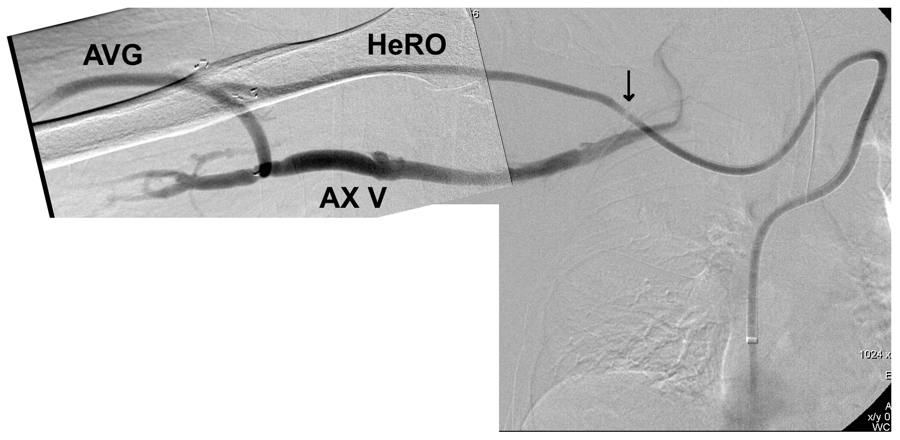Back to Annual Meeting Program
Modified Use of the HeRO Device for Immediate Salvage of a Threatened Dialysis Graft
Angela T Prescott, Bassan J Allan, Arash Bornak, Marwan Tabbara, Lee J Goldstein
University of Miami, Miami, FL
BACKGROUND
The Hemodialysis Reliable Outflow (HeRO) device provides an additional access option for hemodialysis in patients with central venous occlusions. The HeRO device is a subcutaneously tunneled dialysis access device comprised of a standard 6mm ePTFE graft coupled to a nitinol reinforced 5mm venous outflow component. Standard placement involves tunneling the venous outflow component to the right atrium via the internal jugular vein and anastamosing the graft component to the brachial artery. This case illustrates a modified technique, employing the device for immediate salvage of a malfunctioning upper extremity dialysis graft with ipsilateral central venous occlusion.
We report successful salvage of a failing arteriovenous graft by utilizing a HeRO device anastomosed to the graft and tunneled to the contralateral internal jugular vein.
METHODS/CASE REPORT
A 69-year-old male on hemodialysis for five years presented complaining of right upper extremity edema and pain worsened during hemodialysis. His dialysis access consisted of a right upper extremity 4-7 mm tapered brachio-axillary arteriovenous ePTFE graft (AVG) created two years prior to this admission (Figure, AVG). He had previously undergone a left basilic vein transposition and left brachio-axillary graft with subsequent removal of the graft due to infection.
Despite adequate flow rates through the existing dialysis graft, his symptoms prompted a diagnostic fistulogram that demonstrated a patent right axillary vein (Figure, AXV), and occlusion of the right subclavian vein. Endovascular attempts at recanalization of the subclavian vein were unsuccessful. Central venography from a femoral vein approach demonstrated a right internal jugular vein occlusion, but patent superior vena cava, left innominate vein, and left internal jugular vein.
Using ultrasound, the left internal jugular vein was accessed and a wire was passed into the right atrium under fluoroscopy. After establishing central venous access to the superior vena cava, the venous outflow component of the HeRO device was introduced following serial dilation of the tract. The device was then tunneled subcutaneously along the anterior chest wall to a counter incision at the right (contralateral) deltopectoral groove where the 6mm HeRO ePTFE graft was coupled to the venous outflow component (Figure, arrow). A 2.5 cm incision was made at the distal (venous) end of the AVG, and the HeRO ePTFE graft was further tunneled from the coupler incision site to the AVG incision site. The new ePTFE-HeRO system was finally anastamosed in end-to-side fashion to the AVG.
RESULTS
A completion fistulogram was performed through the fistula, which revealed brisk flow via the HeRO, into the central venous system and right atrium (Figure, composite fistulogram). Dialysis was instituted the following day with flow rates of approximately 400 ml/min. The patient has successfully continued hemodialysis via his HeRO device for eight months without complications and with relief of his preoperative symptoms.
CONCLUSIONS
This unique approach with the HeRO device allows graft salvage with immediate use while obviating the need for complex surgical reconstruction for dialysis access. 
Back to Annual Meeting Program
